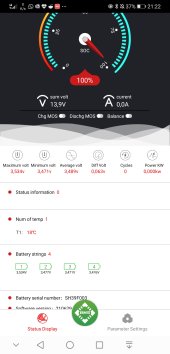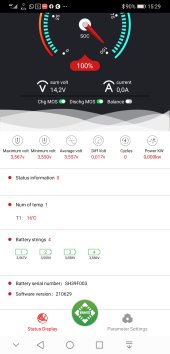Connections everything I checked. The first cell is off Bij 60 to 90mv .I think I am gonna add an active balancer. Only use it at high SOC. Any suggestions for an active balancer? The heltec 5a is that a good one?
The Heltec 5a active balancer is used in my system with two grade B 271ah 8s 24 VDC Lifepo4 battery banks and it works well.
For 4s 12VDC Lifepo4:
For 8s 24VDC:
There are (run) solder pads on the Heltec active balancer that can be used to turn the balancer on and off with a switch.
My system uses the relay on the Victron Energy BMV 712 battery shunt display wired to the run solder pads to switch on and off the Heltec active balancer.
At voltages above 27.3VDC the Heltec active balancer is switched on and balancing begins. As the voltage continues to increase above 27.3VDC the Solar Charge Controllers in the system are programmed to go into Boost (absorb) charge at 28 to 28.2VDC for 10 minutes. During boost charge mode the Heltec active balancer keeps all cell voltages at less than 3.55VDC as the cells balance. At the end of 10 minutes of boost charge mode all cells are within 30 mv or less. After 10 minutes of boost the SCC's are programmed to go into float mode at 27.4VDC. The cells continue to balance and after a few minutes in float the cells are within 15 mv or less. The SCC's stay in float mode while suppling loads during the day. Toward the end of the day (or if clouds build) when SCC's cannot hold float and the battery voltage goes below 27.2 the active balancer is turned off by the Victron shunt relay.
Originally the Heltec active balancer was just wired to the cells and it ran all the time, but I found that cells would balance mid charge and when the voltage approached the boost voltage at high current charge, some of the cells would trigger the BMS cell voltage limit (3.65 VDC) and shut down the battery bank. During mid charge of the battery banks some of the cells can vary 30mv or more and the Heltec balancer would balance the cells at mid voltage throwing off my top balance. I guess that's due to grade B poorly matched cells. Once the Heltec active balance was triggered to only balance at 27.3 VDC and above everything worked fine.
Due to the load demands on my off grid solar system it may be weeks before the system is able to charge up to Boost (absorb) charge level of 28 to 28.2VDC depending on sunny vs cloudy days in my area. Even with that amount of time in-between boost (full charge) the cells still balance well with the Heltec 5a active balancer. Without the Heltec active balancer one or more of the battery bank cell(s) was prone to over voltage triggering a BMS disconnect on that battery bank.
With my two Overkill Solar 8s BMS set at 3.65 Cell Voltage Limit this works well for both battery banks that are in parallel configuration.
It is my understanding that a Digital low voltage battery cut-off relay module is able to turn on and off the Heltec active balancer like the Victron shunt relay, but I have not tried it since my system has the Victron BMV 712 shunt. If some tries this battery cut-off relay module please post your results here.





